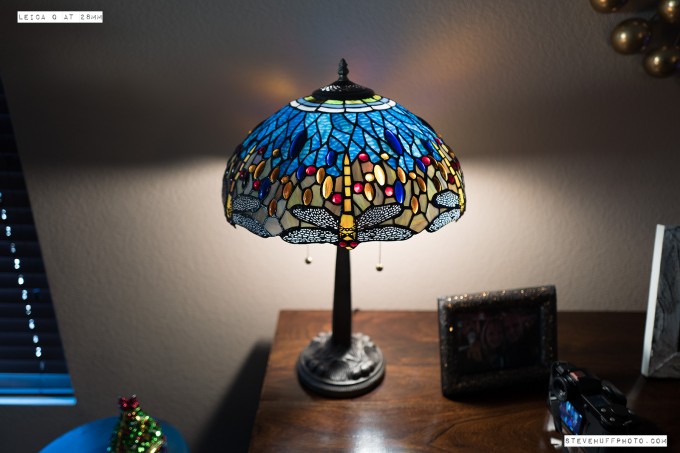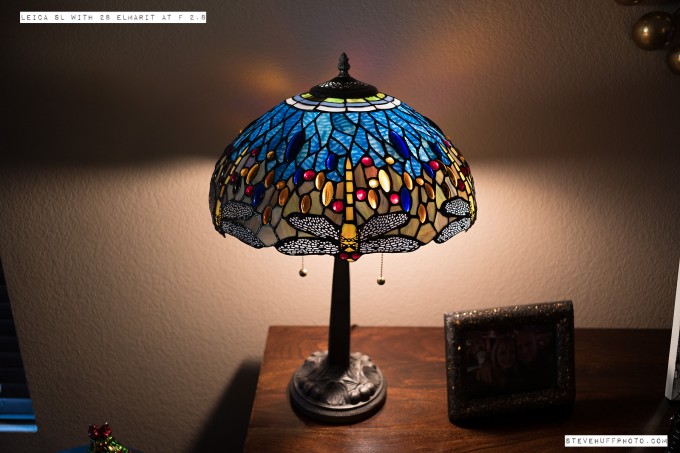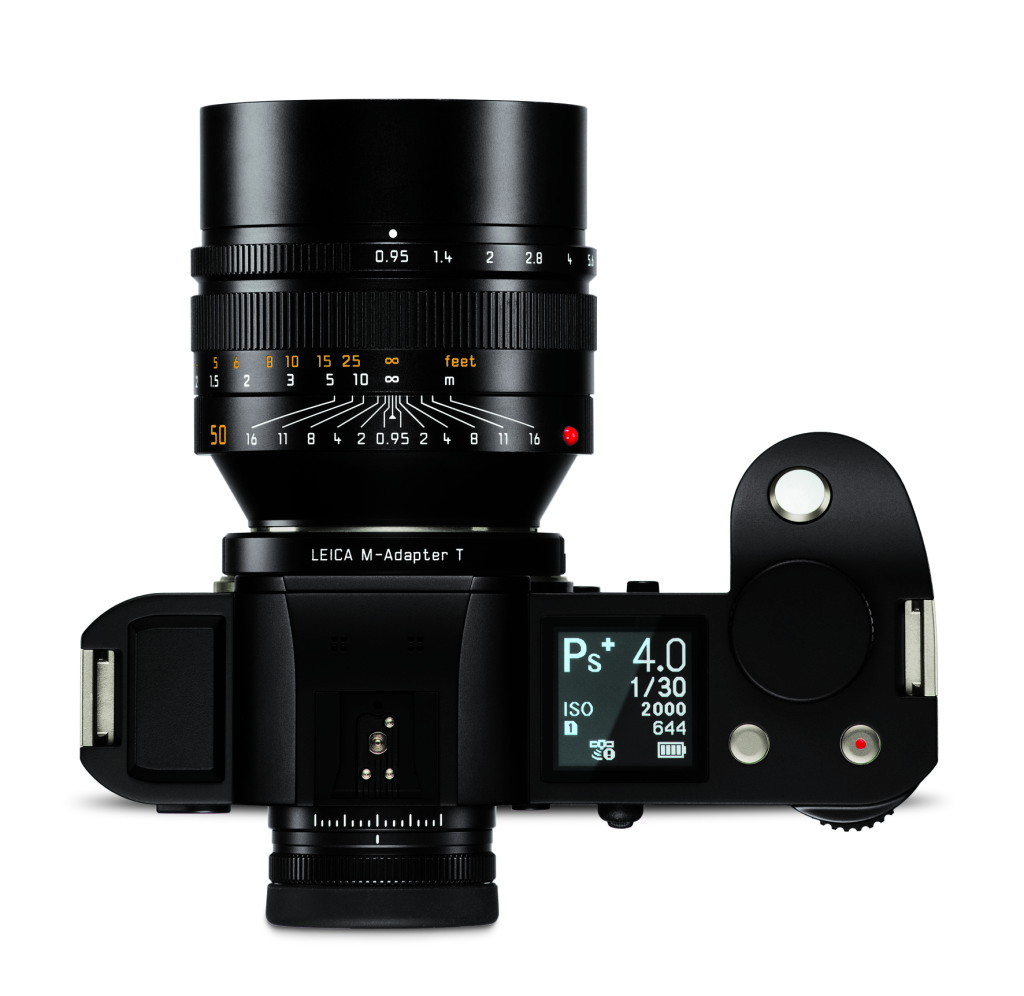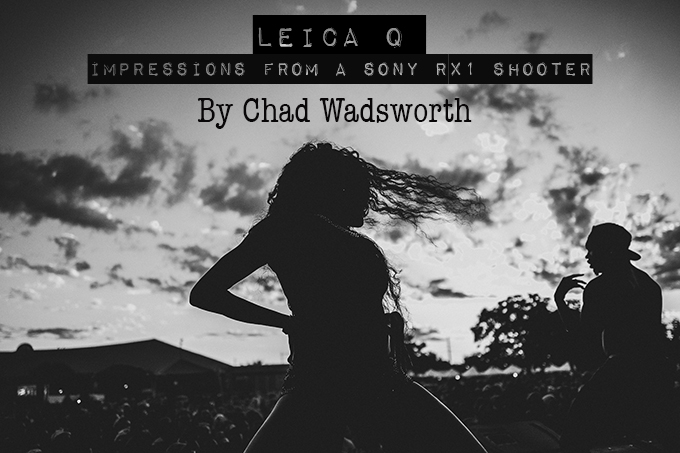TWO Shots. Leica Q vs the Leica SL with 28 Elmarit M
JUST FOR FUN to see differences in color rendering and AWB performance of these two cameras. With that said, I was testing a 28 Elmarit on the SL and figured it would be a nice alternative to the 24-90 Zoom (due to size). Since the Q uses a 28mm lens, I figured “why not”. I snapped a photo of my table lamp with each camera and shot in RAW format. I then loaded my SD card and exported the RAW files to JPEG’s without any added PP or tweaks. The color as you see below is exactly what came out of each cameras RAW file, and what a difference it is.
The SL is warm, rich and a little more bolder than real life. The Q is way cooler in color temp and not really like what I see in real life. Interesting as both of these use the same sensor, but as I say, IQ is much more than a sensor. The way it is implemented makes a huge difference. IN the SL, it is tweaked and implemented differently than the Q, which is why we get two different looks from two cameras that use the same sensor.
This is not a sharpness, bokeh or scientific test. This was specifically to test the color output from each camera without tweaks as many have asked me why or how I could rate the SL higher in IQ than the Q and this shows why. The SL AWB is superior to any camera I have used, and while not perfect, it is as close to it as I have seen in AWB from any digital.
BOTH samples are super, but both are somewhat different. My wall behind the lamp in real life is sort of tan/mocha and the SL shot nailed that color. The Q made it appear off white.
Must click the images to see them correctly
BTW, my Sony RX1RII review will be up THIS Friday! Finally! Then I will start working on my Part 2 review of the Leica 50 APO lens, as used on the SL (Part 1 was the M and Sony A7s). That should be ready to post in 1-2 weeks from now. I will say this…the 50 APO is still IMO the best 50 in the world, and it should be for the cost. On the M and SL it is just so “right”.
Check back tomorrow for more guest posts and then Friday for my RX1RII review!







I don’t understand why Leica couldn’t nail the focal length on the Q’s 28mm lens. It’s actually 26mm, not 28mm. What’s up with that? QA issues? Intentional? I don’t get it.
different point of view, that means different light temperature through the window the is in the frame and not. so not comparable conditions.
but finally I don’t get the point here. I want my camera, doesn’T matter if it is leica, canon ,nikon or whatever, do create the colors I want due to the post processing. so the colors that a development team at leica prefer are not important for me.
Would be nice to add the Sony FE 28/2 to this comparison.
Hi Steve,
If you use aperture 2.0 with one and f2.8 with the other you will have different shutter speeds. or did You set both cameras on manual mode? If so, which shutter speed did You use with both cameras? I am asking, because beside of the white balance a difference in shutter speed/aperture also often will result in different color temperature in the final picture. Do judge the AWB on both cameras fairly i think You will need to set both cameras manually to the exact same settings with AWB .
Exactly Robert; this is what I meant with an earlier comment. Difference in aperture and therefore also dof will also result in slightly different – colour – rendering.
I would be very interested to see the same pictures with identical and manually set aperture and shutter speed for better comparison.
Often and not only on this site and with other camera brands other then Leica the colour out of cameras are commented on. Having camera M 240 set to RAW and Auto WB most of the time to me colour out of the camera is meaningless as files that I process in Lr is what matter to me, or am I missing here something?
Color out of camera meaningless? Sure, if it’s shitty. When its spot on, makes life so much easier.
Useful comparison, but it raises lots of questions. It would be nice if you could make the original raw files available to some of us to see it the image difference here can be eliminated in Lightroom or PS by simply warming the white balance. Why? The images of the SL posted on the web are quite good, as you’ve said here. For those of us who bought the Q, it would be nice to know if its images can be tweaked to approximate the same type of image. The still life images of the SL on the web, and landscapes, look like rich paintings. But one of the Q reviewers noted that its images look like paintings as well. That’s what many of us would like to create for some images.
Oddly, the new Leica S medium formate camera also produces the same painterly images at twice the cost. Interesting that by rounding, you can get the S for $ 16,000 w/o lens, the SL for half of that or $8,000 and the Q for half of that or $4,000. The weight also goes down with each step. The S definitely has a different sensor than the SL, but the images from the SL are quite similar. The Q is supposed to have the same sensor as the SL (24MP), but as you’ve shown, the images are outstanding as well but not as painterly-like. This has been attributed to Leica “tweaking” the Q sensor to use in the SL camera. I don’t buy that at all, if by tweaking you mean manufacturing the sensor itself in some slightly modified form. That would see too expensive to me, to develop, engineer, and manufacture while you’re already manufacturing one that is outstanding. The Ricoh GR and its Nikon competitor also supposedly had the same SONY sensor, but implemented them differently in their respective cameras. By implemented, I assume they meant the firmware, in ways that would match the lenses. Images of both are great, but testers noticed the differences. The difference was in the “tweaking” of the software in the camera.
Modifying the firmware is a better explanation for what appears to be real. Both the SL and the Q were produced with the Leica S’s new Maestro II Image Processor. So, all three. The differences in images, if they exist should be due to the way that software was modified/implemented for each camera. If so, this raises a very important point. The SL has already issued an upgraded version of its firmware. The Q has not. Would Leica ever issue an upgrade to the firmware of the Q so that there would be an option to emulate the image characteristics of the SL. Why not, if the processor and sensor are the same? Or would PS/Lightroom processing due the same trick?
Weight: S without lens, 2.8 lbs. SL without lens, 2.5 lbs. and with it’s new zoom lens, 4.37 lbs. Leica Q with built-in lens and body, 1.4 lbs. Moreover, the Q fits perfectly inside the leather half case for the well known, Leica M6. A right size, in other words, if you don’t want a DSLR.
Im sure you could tweak it but at the end of the day, the SL has lens options and the Q does not. Both are fantastic depending on your needs.
Hi Steve,
If the Q image can be tweaked with firmware to match that of the SL, then why wouldn’t Leica be doing that already? It’s not the lenses. In the Tomer Vaknin short review submitted after this one, he uses four different lenses. He gets the same outstanding type of image from all of them. Presumably, if he could take the Q 28mm lens and use it on the SL, he would still get that same type of image. Apart from the usual Leica camera quality, it’s the sensor that’s delivering this image quality along with the engine that’s processing it. I assume and certainly hope that the next Leica M (after the 240) will match that level of image quality as well.
I think he’s on to something with the price though. The Q is half the price of the SL and it comes with a fantastic lens. The only AF lens for the SL is that monstrosity of a zoom, so unless you want to break your back and shoulders, manual focusing is the only option, which wipes out 90% of amateurs who are looking for AF cameras. The Q still offers the best bang for your buck in the Leica world. And it’s not even close.
Too bad people won’t be able to buy the RX1R II for at least a month…..still looking forward to your review.
My review may be delayed a few days until I can figure out what is happening with the RX1RII. Awaiting a reply on the delay from Sony. After that the review will be up.
That’s a bummer — looking forward to the review, too. SonyAlphaRumors.com had a tip that the problem was autofocus inconsistency, but will be interested to hear the official announcement.
Steve: Don’t mean to hi-jack this thread but given that your RX1RII review is coming tomorrow, I’m wondering if you have any information and/or speculation as to why production has been halted?
None at all. I was not informed of any issues but am trying to figure out if I should still post the review tomorrow if there are issues.
IMHO AWB is for p&s camera and smartphones. Most all serious photographers pre-set their white balance according to the situation and/or shoot RAW. AWD gets affected by the color of surfaces so even if you are in the same space lit by 3200k lights just a minor change in composition can result in a different awb response so you might en up with 100 images each with a slightly different WB when they all should be set at 3200k.
I know over 100 pro’s and 75% of them use AWB. So your statement is VERY incorrect. Besides, 80% of who visit this site are NOT pros. They are enthusiasts, amatuers and hobbyists who mostly use AWB. When street shooting and walking in all kinds of changing light, manual WB is not an option. When shooting family snaps on vacation, who wants to mess with manual WB? Pros do not buy the Q or RX1 style cameras so their AWB should be as good as the SL, which IS a “PRO” camera yet excels in AWB. Hmmm.
Personally I use AWB most of the time, because it saves time when shooting. But I fine tune in post. The better the AWB, the lesser fine tune is needed. Again saves time, but also is in favour of the dynamic range. So I regard the AWB quality of the SL definitely as a pro. Although the AWD of my A7RII is also very good and demands very little pp as well. That being said, I’m more interested to compare pictures after pp, because IMO only the final result counts. My question always is: how good can I get it? I would like to see pictures that answer that.
Yeah, although I mentioned above that white balance is easy to fix, AWB is very important. I’d say 95% of my shots are taken using AWB, unless I know I’ll be under the same lighting for a prolonged period of time.
Give the raw data to several for pp, the final image will never look the same. Not knowing that each image was from the same camera and lens, how does anyone go on to make accurate judgements for the camera and lens. If you give a group the opportunity to judge on the basis of the lens they will believe that each photo was taken by a different lens. Maybe everyone will judge that they prefer the lens rendering in photo “A” compared to photos “B” and “C”.
They would look exactly the same if used out of camera as I did here. 🙂
Being a pro vs amateur for the most part means getting paid for your work. If you run a kiosk in a mall you are a professional, but in that environment the white balance is set for the lighting used, overcoming the ambient light from mall lighting. Most amateurs and many professionals don’t know that there is a custom white balance option. If you are a “pro” working with the media you often need to work quickly and under constantly changing light conditions. For their purposes either picture of the lamp would be acceptable. Who, looking at the either photo would be able to judge or care what the correct colors should be; each is acceptable. Those working in portrait and product photography are very keen to the light they are shooting in and adjust accordingly. As one should be taking photos of the lamp. If you’re going to spend $4,000 plus on a camera and have the time then care enough to do your best. If your equipment is used primarily for vacation and casual event shooting (documentation) then it doesn’t matter much. No one, other than you, looking at the pictures will know the difference. But, even then I take the time to do custom white balance. It depends on how much you care about your work. If you are doing serious, caring, deliberate photography taking the little time it takes to do custom white balance means less destructive adjustments in pp.
Yes, the key word here is “serious”. Not whether professional or amateur. “Serious” has little to do with the cost of equipment, as for some the most expensive Leica is no more than pocket change.
Sorry Ken; nonsense. Reliable AWB on a good camera will get you dependable results that will require little if any extensive pp adjustment.
But, how many just go out and buy a camera for reliable AWB? How would you know until you get out and shoot? Depending on the circumstances good enough is good enough. Until you check the RGB values there is not way to know for sure.
Hi FBaron2: Of course. To determine if your camera’s AWB is reliable (and in what lighting situations) takes (a lot of) trial and error; you have to know your tools. In my recollection, my D700 wasn’t so good, the D8xx is good in most situations, but mixed lighting (f.i.: a fierce setting sun and mixed artificial lighting) can still send it haywire, and the corrective measures will have to go a bit further than just adjusting the Kelvin value and will have to include slightly correcting the various conflicting colour casts.
If I’m correct, setting a custom white balance value will do no more than (only) adjust the colour temperature value, but will not account for colour casts.
Please correct me if I/m wrong here.
Anyway, as most viewers of an image will not have been present at the scene, and if they were their visual memory might fall short, 100% correct WB does not seem all that relevant. A credible, natural looking, colour palette is.
Michiel-Interesting question and I don’t have a quick, sure answer. No matter, I go into threshold and mark the whitest white and blackest black. I exit, do not save. Then to curves, and while referencing the RGB values in Info, adjust the RGB values in curves so that the white values equal the highest white value of RGB and then to the blacks and adjust each RGB to equal the lowest recorded value. Get to each the whites and blacks by clicking on that section of the graph. I have several digital cameras that I use regularly but only when I set custom white values with my Sigma DP’s there is usually little adjustment needed. Maybe that is the answer to your question. But, I see little need for printing in color. Even with all the effort to get the pre print color right, it’s impossible with inkjet to print to satisfy all lighting conditions, but with well profiled matte papers doing much better than glossies. Where your color prints look awesome in natural light, but dreadful under artificial lighting. Thankfully, most viewers are not very discerning. Nearly all my printing is with black & white using all carbon based inks that are immune to varying light conditions, and where there is basically no fading. I don’t want someone looking at my color print and have their first comment to be “great colors”.
I understand where you are going with the visual memory and I will sometimes play with the white balance in raw to create a mood or to overcome unavoidable harsh lighting conditions. Mostly, outdoors, I tend to shoot in gloomy, damp evenly lighted, saturated conditions. Even if you display the same image with different WB they may each look great if viewed separately but not side by side.
Not to elevate a professional photographer over an amateur, but I know a professional who shoots with a D8xx but regularly uses a point and shoot. But, he finds it acceptable to identify his images shot with the point and shoot to be from his D8xx. This assures his credibility and no one knows the difference.
Thanks for asking me to comment.
Happy holidays…
Any thoughts that it is the lenses that are warmer/cooler instead of the AWB?
Hello Steve, how is the corners on the 28mm elmarit on th SL? I have the lens for a Leica m in which has wonderful results. But on my a7ii is horrible, only sharp on the center.
So far so good but I have not done extensive tests. So far the images I do have are beautiful. Im going to take a drive later to a nice spot to test corner sharpness, so look out for a short report by the weekend.
Rating a camera on color reproduction is tricky because an accurate color is not always the most pleasing color. And when it comes to white balance, it is one of the easiest things to fix while shooting or processing. I kind of prefer the Q image btw.
Apples to apples I don’t see a $4000 difference.
one is fixed lens and the other is Interchangeable…
Greetings Paul!
…and you don’t have the money for either both of those cameras, that’s your point?
Actually I do have the money and do own a Q.
I hope Leica will launch the SL guts without autofocus in a M housing. That would be my ‘must have ” camera.
I will predict an all new M in 2016. It will be MUCH different than the 240 and pretty exciting. Just my guess. 🙂
I can see that too. They could have four full-frame systems, with three utilizing M lenses. The Q with the fixed lens. The SL with EVF and autofocus lens options. The classic M262 with rangefinder and minimal features for the traditionalist. And a new M with no autofocus, slightly updated M look, EVF, video. The last one would be my dream.
Interested in the white balance without a grey card. I know with a predominant color in the scene, the white balance can change with focal length or composition. The color photo may actually have a better neutral gray with no other info to go on. AWB is so easily fooled. Would be interesting to see more comparisons.
You are exactly right…
I only see a difference in white balance settings.
Meaning, why depend on AWB when you can properly use custom WB.
Yes, that’s all I’m seeing too. It doesn’t look like a difference in color rendition. I bet if a gray card was used to tweak the WB, you could get the color to be identical.
As stated, this is a test for OOC AWB. A camera should do a good job with AWB and most do. Some fall short, and some are awful. This, as stated, is a comparison of OOC AWB/COLOR and this is what you get out of each camera. Also, the SL files, when shot RAW are superior to the Q’s besides color in every way. Why is that? Because I can use much nicer lenses on the SL where with the Q I am stuck with one 28mm lens, and the lens is 80% of your IQ, character, color, contrast, pop, depth, etc. So the SL has a potential for much greater IQ anyway. With the fantastic AWB, noise performance and color that is superior to any other digital I have ever tested, it’s just so so good.
why do you call a noise performance better on the SL if they are of the same sensor, and eventhough it is tweaked i dont think it does a lot of things in RAW
You’re only stuck if after you buy the camera you foolishly discover that it comes with a fixed lens.
Other than the white balance, what I find striking is the difference in depth of field. Steve, what apertures did you use for these? To me, the Q has a much shallower depth of field with the wall nicely out of focus.
That is because the Q was at f/2 and the SL at 2.8
Error on note with images…both says 2.8.
That difference in aperture makes the comparison a little bit more difficult.
Easy to see the depth of field differences, especially if it is f2 vs f2.8. I assumed that both were shot the same before reading the comments and wondered why so much of a difference. Hand held or tripod?
I’m using the 28 Elmarit M on my SL and am finding the same. IQ is just outstanding on the SL, spot on color rendition.